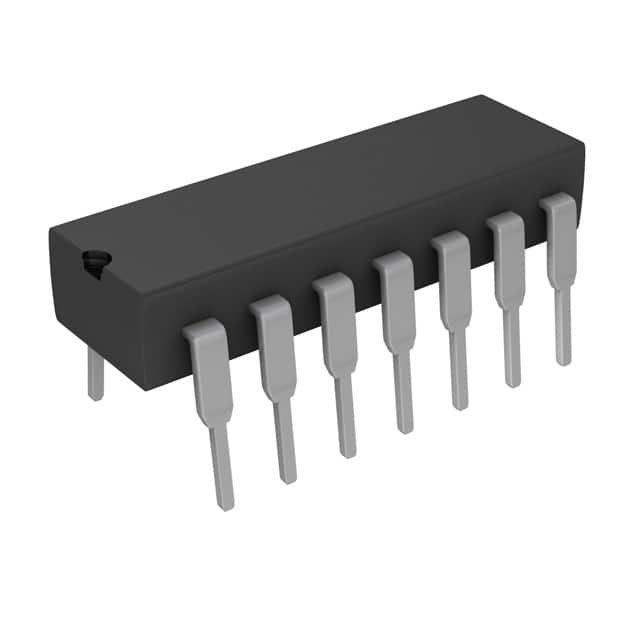MSP430G2001IN14
Product Overview
The MSP430G2001IN14 belongs to the family of MSP430 microcontrollers, which are ultra-low-power mixed-signal microcontrollers from Texas Instruments. These microcontrollers are widely used in various applications due to their low power consumption and high performance.
Basic Information
- Category: Microcontroller
- Use: Embedded systems, IoT devices, sensor nodes
- Characteristics: Ultra-low power consumption, high performance, integrated peripherals
- Package: 14-pin DIP (Dual Inline Package)
- Essence: Efficient and versatile microcontroller for low-power applications
- Packaging/Quantity: Typically available in reels of 250 or 3000 units
Specifications
- CPU: 16-bit RISC architecture
- Clock Speed: Up to 16 MHz
- Memory: 2KB Flash, 128B RAM
- Peripherals: GPIO, Timer, ADC, Comparator
- Operating Voltage: 1.8V to 3.6V
- Low Power Modes: Multiple low-power modes for energy efficiency
Detailed Pin Configuration
The MSP430G2001IN14 features a 14-pin DIP package with specific pin assignments for power, I/O, and communication interfaces. The detailed pin configuration can be found in the official datasheet provided by Texas Instruments.
Functional Features
- Ultra-Low Power Consumption: Ideal for battery-powered applications
- Integrated Peripherals: GPIO, Timer, ADC, and Comparator for versatile functionality
- High Performance: 16-bit RISC CPU for efficient processing
- Flexible Operating Voltage: Wide voltage range for compatibility
Advantages and Disadvantages
Advantages: - Ultra-low power consumption - Integrated peripherals reduce external component count - High-performance RISC architecture
Disadvantages: - Limited memory compared to higher-end microcontrollers - Limited number of I/O pins for complex applications
Working Principles
The MSP430G2001IN14 operates on the principles of ultra-low power consumption and efficient processing. It utilizes multiple low-power modes to minimize energy consumption while providing the necessary computational capabilities for embedded systems and IoT devices.
Detailed Application Field Plans
The MSP430G2001IN14 is well-suited for a wide range of applications including: - Battery-powered devices - Sensor nodes - Wearable electronics - Home automation systems - Industrial control systems
Detailed and Complete Alternative Models
- MSP430G2231: Higher memory and more I/O pins
- MSP430G2553: Enhanced peripherals and communication interfaces
- MSP430FR2000: FRAM-based memory for non-volatile data storage
In conclusion, the MSP430G2001IN14 is a versatile microcontroller with ultra-low power consumption and integrated peripherals, making it an ideal choice for various low-power applications.
Word Count: 410
Senaraikan 10 soalan dan jawapan biasa yang berkaitan dengan aplikasi MSP430G2001IN14 dalam penyelesaian teknikal
What is the MSP430G2001IN14?
- The MSP430G2001IN14 is a low-power microcontroller from Texas Instruments, featuring a 16-bit RISC CPU, 2KB of flash memory, and 128 bytes of RAM.
What are the typical applications for the MSP430G2001IN14?
- It is commonly used in applications such as sensor nodes, battery-operated systems, and other low-power embedded systems.
What are the key features of the MSP430G2001IN14?
- Some key features include low power consumption, integrated peripherals, and a wide operating voltage range.
How do I program the MSP430G2001IN14?
- The MSP430G2001IN14 can be programmed using the MSP430 LaunchPad development kit or other compatible programming tools.
What are the power requirements for the MSP430G2001IN14?
- The MSP430G2001IN14 operates at very low power, typically requiring a supply voltage between 1.8V and 3.6V.
Can the MSP430G2001IN14 interface with external devices?
- Yes, it can interface with various external devices through its GPIO pins, SPI, I2C, and UART interfaces.
What kind of development environment is needed for working with the MSP430G2001IN14?
- You can use the Code Composer Studio IDE or Energia, which is an open-source electronics prototyping platform.
Does the MSP430G2001IN14 have built-in analog-to-digital converters (ADCs)?
- Yes, it has a 10-bit SAR ADC with multiple channels for analog input.
What are the communication interfaces supported by the MSP430G2001IN14?
- It supports SPI, I2C, and UART communication interfaces for connecting to other devices.
Are there any known limitations or challenges when using the MSP430G2001IN14?
- One potential challenge is the limited amount of flash memory and RAM, which may require careful optimization of code and data storage.


